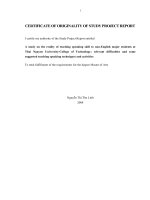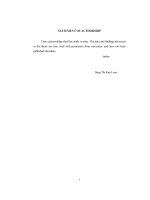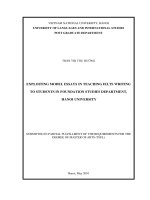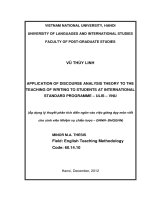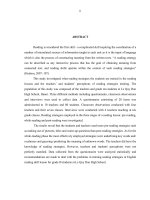exploiting model essays in teaching ielts writing to students in foundation studies department hanoi university
Bạn đang xem bản rút gọn của tài liệu. Xem và tải ngay bản đầy đủ của tài liệu tại đây (566.34 KB, 65 trang )
VIETNAM NATIONAL UNIVERSITY, HANOI
UNIVERSITY OF LANGUAGES AND INTERNATIONAL STUDIES
POST GRADUATE DEPARTMENT
TRẦN THỊ THU HƯỜNG
EXPLOITING MODEL ESSAYS IN TEACHING IELTS WRITING
TO STUDENTS IN FOUNDATION STUDIES DEPARTMENT,
HANOI UNIVERSITY
SUBMITTED IN PARTIAL FULFILLMENT OF THE REQUIREMENTS FOR THE
DEGREE OF MASTER OF ARTS (TEFL)
Hanoi, May 2010
iii
TABLE OF CONTENTS PAGE
Acknowledgement i
Abstract ii
List of tables and figures v
CHAPTER 1: INTRODUCTION 1
1.1 Statement of the problem and the rationale of the study 1
1.2 Aims of the study 2
1.3 Significance of the study 3
1.4 Scope of the study 3
1.5 Methods of the study 3
1.6 An overview of the rest of the paper 4
CHAPTER 2: LITERATURE REVIEW 5
2.1 Overview 5
2.1.1 IELTS test 5
2.1.2 IELTS Writing test 5
2.1.3 Model essays 6
2.2 Context of teaching IELTS Writing 9
2.2.1 In Vietnam 9
2.2.2 In Foundation Studies Department, Hanoi University 9
2.3 Related studies and fitness of the present study into the field 10
CHAPTER 3: METHODOLOGY 12
3.1 Participants 12
3.2 Instruments 13
iv
3.3 Data collection procedure 14
3.5 Data analysis procedure 15
CHAPTER 14: RESULTS AND DISCUSSION 16
4.1 Results 16
4.1.1 Research question 1 16
4.1.2 Research question 2 21
4.1.3 Research question 3 24
4.2 Discussion of results 26
4.2.1 Research question 1 26
4.2.2 Research question 2 28
4.2.3 Research question 3 30
CHAPTER 5: PEDAGOGICAL IMPLICATIONS AND RECOMMENDATIONS 32
5.1 When to exploit model essays 32
5.2 What elements to exploit from model essays 33
5.3 How to exploit model essays 34
CHAPTER 6: CONCLUSION 38
REFERENCES I
APPENDICES III
v
List of tables and figures
Table 1: Summary of IELTS writing teachers
Table 2: Challenges in using model essays of IELTS Writing Task 1
Table 3: Challenges in using model essays of IELTS Writing Task 2
Figure 1: Aspects of model essays most exploited by teachers in IELTS Writing Task 1
Figure 2: Aspects of model essays most exploited by teachers in IELTS Writing Task 2
1
CHAPTER 1: INTRODUCTION
Introduction
The first chapter states the research problem and justifies the rationale for the study.
Afterwards, three research questions, the aims, scope as well as the methods of the study
are presented. The chapter ends with an overview of later chapters, which acts as a clear
outline for the whole paper.
1.1 Statement of the problem and the rationale for the study
Over the decades, there have been a growing number of English learners wishing to
study at tertiary level in English speaking countries. As a result, many non-native students
are trained to go through English language tests such as the International English Language
Testing Systems (IELTS), which is widely recognized as a language requirement for
entering universities mainly in the United Kingdom, Australia, and New Zealand.
In the standardized IELTS test, academic essay writing is one of the important skills
which international students must acquire both for their prospective studies in English-
mediated courses and for obtaining the required score in the writing section. However, due
to the complexities of learning to write well in a second language, there has been vigorous
debate on more effective teaching methods and feedback among many IELTS writing
teachers. In recent years, several studies on strategic tools for teaching IELTS writing
have been conducted. Emerged from Rick VanDeWeghe’s theory about teaching:
“whatever we want our students to do well, we first have to show them how” (2006), the
use of model essays as one type of strategic tool, unquestioningly plays a crucial role in
assisting teachers to better facilitate students in their writing skills. Being intrigued to
further explore how teachers apply this efficient tool, the researcher makes investigation in
the context of Vietnam for two main reasons.
Initially, in Vietnam recently, teaching IELTS is getting more and more popular in
a larger proportion of educational settings to meet the learners’ demand. However, research
on methods or tools for teaching IELTS in general and IELTS writing in particular has just
kept a modest number. As far as the researcher could find, there has been no research
delving into the exploitation of model essays in teaching IELTS writing. Therefore, the
2
researcher hopes to fill this gap to certain extent by digging deeper into the exploitation of
this powerful teaching tool. Secondly, referring to Vietnamese pedagogical context,
teaching IELTS writing is proven to be challenging due to its nature as well as the high
pressure of achieving the target band score. Such a fact highly demonstrated the need for
researching ways, strategies or tools that help promote effective teaching. Among those
teaching tools, model essays are selected to be the subject matter of investigation. The
researcher expects the study can provide guidelines for Vietnamese teachers to fully
employ model essays as substantial assistance for teaching IELTS writing.
In Foundation Studies Department of Hanoi University, where IELTS has been
taught as one subject to prepare students for the final conditional test, writing section has
kept a part of every lesson. Nevertheless, due to a number of reasons, teaching writing
component still appears hard for teachers owing to their ineffective application of strategic
tools. In this context, the researcher feels an urge to carry out a study on employing model
essays as one efficient teaching tool to guide students for the IELTS writing sub-test at the
end of term.
1.2 Aims of the study
At the outset, this study is an attempt to shed more light on what aspects teachers
explore from the model essays to teach IELTS writing in the target educational setting.
Moreover, this study also aims at investigating some difficulties for teachers when
employing model essays as a teaching tool. Finally, through discovering those problems,
the paper could also serve as a detailed proposal to efficiently exploit model essays in
facilitating students to perform better in IELTS writing test.
In order to achieve the abovementioned aims, the study will be conducted to answer
three research questions:
1. What aspects of model essays do teachers exploit to teach IELTS writing in class?
2. What challenges do teachers probably face when employing model essays in teaching
IELTS writing?
3. What measures could be taken to help teachers overcome those challenges?
3
1.3 Significance of the study
As the present study investigated the use of model essays to teach IELTS writing in
Foundation Studies Department, its benefits to the target population, which are the teachers
of Foundation Studies Department are substantial. Specifically, the study serves as: firstly,
an overall review of what aspects of model essays have been employed in teaching IELTS
writing; secondly, a critical analysis of challenges of applying these strategic tools; and
lastly, a concrete proposal to exploit them effectively in teaching IELTS writing in the
investigated department. Apart from that, teachers who have been teaching IELTS writing
in other educational settings throughout the country can also benefit tremendously from
this paper.
1.4 Scope of the study
The study focused on exploiting model essays to teach writing in IELTS format in
particular, not writing skill in general. Apart from that, due to the small scale of the study,
only Foundation Studies Department, Hanoi University was chosen as the research setting.
The samples of the study, as a result, were restricted to eight teachers. This number of
participants is sufficient to provide valid and reliable information, the contributions of
which are vital to the success of the study. Students were not involved because the research
exclusively delved into how exploitation of model essays assisted the teaching of IELTS,
not the learning process.
1.5 Methods of the study
In order to achieve the aforementioned aims, the study applied such methods as
follows.
As for data collection methods, interviews and observations were delivered to
collect data. Semi-structured interviews were conducted among eight teachers from
different eight classes in Foundation Studies Department. For lesson observations, two
were done and chosen as representative samples to be analyzed in order to validate the data
collected from the first instrument.
As for data analysis methods, the researcher recorded all eight interviews and
they were then transcribed, analyzed and synthesized so as to provide a deeper insight into
4
the matter. Regarding two lesson observations, detailed descriptions were provided first,
followed by in-depth analyses.
1.6 An overview of the rest of the paper
The rest of the paper includes five chapters as follows:
Chapter 2 provides the background of the study, including a review on key
concepts relating to the research topic. This chapter also briefly discusses the literature in
the field to reveal the research gap that needs to be filled.
Chapter 3 presents the research methods adopted in the study. Justifications of the
chosen research instruments as well as their implementation are also provided.
Chapter 4 reveals the results of the research and gives critical interpretations and
analyses of those results. Subsequently, the discussion refers back to the literature in the
research areas to show both the similarities and differences in the findings.
Chapter 5 gives recommendations for employing model essays effectively to teach
IELTS Writing at the target department from pedagogical perspectives.
Chapter 6 summarizes the major findings of the study, and then indicates some
contributions as well as limitations of the study. In addition, suggestions for further study
are put forward. Following this chapter are Appendices and References.
Conclusion
In brief, the chapter has discussed the research problem, rationale for the study,
significance, scope as well as methods of the study. Ending the chapter is the overview of
the rest of the paper. With such contents, this chapter acts as a guideline or orientation for
the development of the later chapters of the study.
5
CHAPTER 2: LITERATURE REVIEW
Introduction
This chapter gives an overview of the literature of the study, including the key
concepts and related research in the field to disclose the research gap, which will be filled
to a certain extent by the present study. Simultaneously, it also provides the context of
teaching IELTS writing in Vietnam in general and in the investigated department in
particular.
2.1 Overview
2.1.1 IELTS test
IELTS is a set of examinations managed by the British Council, the University of
Cambridge ESOL Examinations, and IDP IELTS Australia. IELTS has become increasingly
recognized as a “secure, valid and reliable indicator of true to life ability to communicate
in English for education, immigration and professional accreditation” (UCLES, 2007,
p.3). It has been adopted by many English-medium universities all over the world, mainly
in the United Kingdom and Australia.
There are two modules in IELTS, namely academic and general. The former is for
candidates expecting to study at tertiary level, while the latter is mainly for immigration
purposes.
The test is divided into four sections: speaking, listening, reading, and writing.
Speaking and listening sections in both general and academic module are the same while
reading and writing tasks are completely different. This study particularly works on the
academic module, which serves study purposes.
2.1.2. IELTS writing test
2.1.2.1 Test format
The IELTS writing test (academic module) embraces two distinct tasks. In Task 1,
examinees are required to write a short description of information presented in the visual
data such as charts, tables and diagram. The minimum length of their essay is 150 words.
In Task 2, candidates are expected to write an argumentative essay in response to
controversial issue or emerging problem. They have to show an ability to demonstrate an



